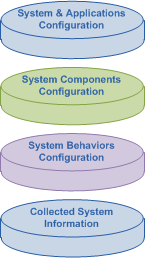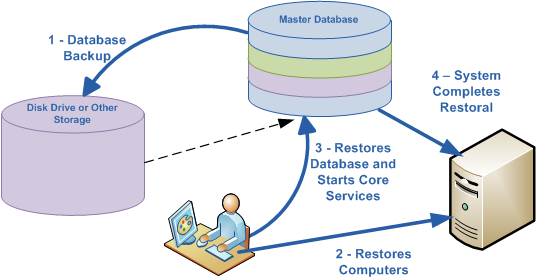ESMS is Defined By A DatabaseWhile ESMS is a family of OLPT (On Line Transaction Processing ) applications (as We require that a system must be fully restorable from a backup of the system’s central database. This means everything. The figure illustrates a complete rebuild of a system. An administrator would reinstall applications on new computers to rebuild the system. Then the database backup would be loaded into the master database. Now applications would be started on local and remote computers and they would automatically recover to how they were at the time of the backup. Most systems allow administrators to control the data fields (columns) accessible by users. This is standard. ESMS provides a significant extension of this capability by providing a simple means to control the rows that different users see in the same tables. This is extremely powerful when multiple clients are using ESMS as a shared service. Each only sees their own even though a single instance of ESMS is operating. Individual clients can also partition their own data to provide powerful controls over their data security. Powerful tools enable real-time calculation of results from streams of transactions. Each result may be accessed immediately from anywhere by any authorized application. Accumulating the volume of product that flows through a pipeline, calculating the emissions rate from flares, calculating the total emissions between different times, or counting the number of vehicles in a garage are simple examples of this capability. The mechanisms needed to create customized results are built into ESMS. |
||

| About Us | Services | Support | Experience | Locations | |
| Home > ESMS is the Best > Capabilities > ESMS is Defined By A Database | |||||
 opposed to a client server application running against a central database), it requires data for configuration of itself and its applications, for configuration of edge components and field devices, for defining its behaviors, and for logging all kinds of transaction data and operator actions. Real time post-processing of transactions that produce critical business intelligence information is also added to the database. The ESMS database is GIS aware making the development of powerful GIS based applications easier to achieve. Things with location have properly typed geospatial coordinates. All of these capabilities demand a powerful database and ESMS’s is Oracle, today Oracle 11g. This standard has proven it robustness, suitability for data replication, and power.
opposed to a client server application running against a central database), it requires data for configuration of itself and its applications, for configuration of edge components and field devices, for defining its behaviors, and for logging all kinds of transaction data and operator actions. Real time post-processing of transactions that produce critical business intelligence information is also added to the database. The ESMS database is GIS aware making the development of powerful GIS based applications easier to achieve. Things with location have properly typed geospatial coordinates. All of these capabilities demand a powerful database and ESMS’s is Oracle, today Oracle 11g. This standard has proven it robustness, suitability for data replication, and power. 